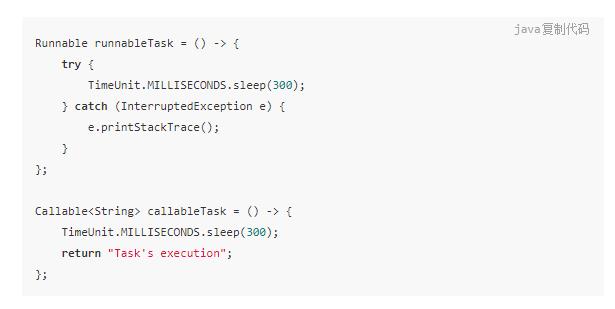java并发中ExecutorService的使用
Posted
tags:
篇首语:本文由小常识网(cha138.com)小编为大家整理,主要介绍了java并发中ExecutorService的使用相关的知识,希望对你有一定的参考价值。
java并发中ExecutorService的使用
ExecutorService是java中的一个异步执行的框架,通过使用ExecutorService可以方便的创建多线程执行环境。
本文将会详细的讲解ExecutorService的具体使用。
创建ExecutorService
通常来说有两种方法来创建ExecutorService。
第一种方式是使用Executors中的工厂类方法,例如:
ExecutorService executor = Executors.newFixedThreadPool(10);
复制代码除了newFixedThreadPool方法之外,Executors还包含了很多创建ExecutorService的方法。
第二种方法是直接创建一个ExecutorService, 因为ExecutorService是一个interface,我们需要实例化ExecutorService的一个实现。
这里我们使用ThreadPoolExecutor来举例:
ExecutorService executorService =
new ThreadPoolExecutor(1, 1, 0L, TimeUnit.MILLISECONDS,
new LinkedBlockingQueue<Runnable>());
复制代码为ExecutorService分配Tasks
ExecutorService可以执行Runnable和Callable的task。其中Runnable是没有返回值的,而Callable是有返回值的。我们分别看一下两种情况的使用:

将task分配给ExecutorService,可以通过调用xecute(), submit(), invokeAny(), invokeAll()这几个方法来实现。
execute() 返回值是void,他用来提交一个Runnable task。
executorService.execute(runnableTask);
复制代码submit() 返回值是Future,它可以提交Runnable task, 也可以提交Callable task。 提交Runnable的有两个方法:
<T> Future<T> submit(Runnable task, T result);
Future<?> submit(Runnable task);
复制代码第一个方法在返回传入的result。第二个方法返回null。
再看一下callable的使用:
Future<String> future =
executorService.submit(callableTask);
复制代码invokeAny() 将一个task列表传递给executorService,并返回其中的一个成功返回的结果。
String result = executorService.invokeAny(callableTasks);
复制代码invokeAll() 将一个task列表传递给executorService,并返回所有成功执行的结果:
List<Future<String>> futures = executorService.invokeAll(callableTasks);
复制代码关闭ExecutorService
如果ExecutorService中的任务运行完毕之后,ExecutorService不会自动关闭。它会等待接收新的任务。如果需要关闭ExecutorService, 我们需要调用shutdown() 或者 shutdownNow() 方法。
shutdown() 会立即销毁ExecutorService,它会让ExecutorServic停止接收新的任务,并等待现有任务全部执行完毕再销毁。
executorService.shutdown();
复制代码shutdownNow()并不保证所有的任务都被执行完毕,它会返回一个未执行任务的列表:
List<Runnable> notExecutedTasks = executorService.shutdownNow();
复制代码oracle推荐的最佳关闭方法是和awaitTermination一起使用:
executorService.shutdown();
try {
if (!executorService.awaitTermination(800, TimeUnit.MILLISECONDS)) {
executorService.shutdownNow();
}
} catch (InterruptedException e) {
executorService.shutdownNow();
}
复制代码先停止接收任务,然后再等待一定的时间让所有的任务都执行完毕,如果超过了给定的时间,则立刻结束任务。
Future
submit() 和 invokeAll() 都会返回Future对象。之前的文章我们已经详细讲过了Future。 这里就只列举一下怎么使用:
Future<String> future = executorService.submit(callableTask);
String result = null;
try {
result = future.get();
} catch (InterruptedException | ExecutionException e) {
e.printStackTrace();
}
复制代码ScheduledExecutorService
ScheduledExecutorService为我们提供了定时执行任务的机制。
我们这样创建ScheduledExecutorService:
ScheduledExecutorService executorService
= Executors.newSingleThreadScheduledExecutor();
复制代码executorService的schedule方法,可以传入Runnable也可以传入Callable:
Future<String> future = executorService.schedule(() -> {
// ...
return "Hello world";
}, 1, TimeUnit.SECONDS);
ScheduledFuture<?> scheduledFuture = executorService.schedule(() -> {
// ...
}, 1, TimeUnit.SECONDS);
复制代码还有两个比较相近的方法:
scheduleAtFixedRate( Runnable command, long initialDelay, long period, TimeUnit unit )
scheduleWithFixedDelay( Runnable command, long initialDelay, long delay, TimeUnit unit )
复制代码两者的区别是前者的period是以任务开始时间来计算的,后者是以任务结束时间来计算。
ExecutorService和 Fork/Join
java 7 引入了Fork/Join框架。 那么两者的区别是什么呢?
ExecutorService可以由用户来自己控制生成的线程,提供了对线程更加细粒度的控制。而Fork/Join则是为了让任务更加快速的执行完毕。
本文的代码请参考github.com/ddean2009/l…
以上是关于java并发中ExecutorService的使用的主要内容,如果未能解决你的问题,请参考以下文章